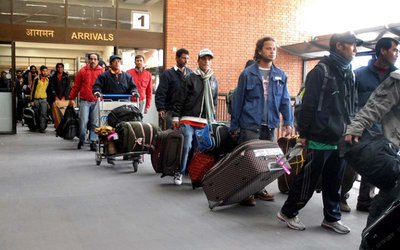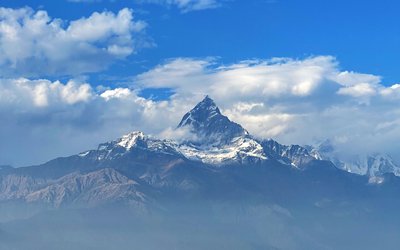I remember reading some time back book ‘The Wind Cannot Read’ by Richard Mason. Titled after a Japanese poem, it reminded me that the bamboo plant survives because it bends with the wind. I was therefore glad to read recently that the local authorities in Doti were planting bamboos along the river banks to prevent ravages by the waters during the monsoon season. This was a very good move – in fact killing two birds with one stone. Like the Chinese culture and cuisine, we have in Nepal a bamboo dependent heritage. I remember reciting as a child the ditty,
Tama tusa, ghara ghara moosa,
Okhale bajiyako kan samata!
We in Nepal have eaten and grown up with tusa shoots from various Pareba / other bhirs or from cultivated bamboo groves. Bamboo shoots are delicacies for pandas too whilst the mature stem, being utilised for scaffolding, bridges, houses and buildings in countries of Asia is an essential item.
When our rivers are being excavated willy-nilly for gravel, sand and boulders the likelihood of damage to the banks increases manifold. One has only to think of the massive destruction that increased global warming has done with fires in US and Canada. The estimate is that 364,000 acres of forests have been destroyed. Together with this the floods in China and Europe have done extensive damage. Drastic steps must be taken by every one of us all over the world to save it, with its flora and fauna, for future generations. Thankfully we in Nepal had days of tree planting forays and also laid stress on Community forestry in the Panchayat days. Whilst new projects are essential e.g. new airport and the road to it, tree cutting should be a minimum and three or four saplings planted in the area for every tree cut.
A thought expressed in Nepali papers is about the planting of trees along our city roads. The current favourite seems to be jacaranda which, when in bloom, presents a very pleasant vision to our eyes. The disadvantage of this tree is the shedding of flowers and leaves which soon occurs and creates an expensive clearing up requirement. Perhaps we need to opt for evergreen trees which do not shed leaves too often. During late King Birendra’s reign the road to Tribhuvan International Airport at Kathmandu had been planted with cherry blossom saplings from Japan and was a very nice sight on one’s drive to the airport. Sadly many have now died but some have been replaced by Asare phool and aaro trees which are more suited for Nepal. In this context I recollect seeing the small berries and crab apple trees along city road pavements in Ottawa, Canada. On enquiry I was told that these have been planted so that the birds of the city will have something to eat. What consciousness! Let our horticultural experts advice us about appropriate trees for our pavements.
The book ‘Mutiny on the Bounty’ narrates the tale of the ship that sailed from England in 1747 CE to Tahiti to collect breadfruit saplings for transplantation in the West Indies. The aim was that when grown these would provide a cheap food source for the slaves that the British had in the Caribbean! My point here is that we have to plant trees which produce food which the people can feed on too. During the time of PM Nagendra Prasad Rijal he had had planted mango saplings along the East West highway with very good intentions. Whether adequate care was taken of these saplings and if any produced mangoes I am not sure. Apples and oranges growing are prevalent in Nepal but stress needs to be given to widespread development of planting trees of kattar, lapsi, pomellos, guavas, avocado, kiwi, ainselu and other fruits for consumption by the Nepalis. We should be self sufficient and not importing such items from outside of Nepal.
The word bread in breadfruit, turn my thoughts to the phrase; ‘Man does not live by bread alone’. Our new government should last for eighteen months. Besides efforts in the agricultural sector, the stress by it has also to be on manufacturing various items that are daily requirements of us Nepalis. To ensure this, there should be a work force paid adequately, but it also must work in a diligent fashion, without the political, union shenanigans to disrupt work. This is a prime national need for producing goods for Nepal. One notes that the Nepalis working in the Police force in Singapore are highly regarded. Other Nepali working in Korea, Japan and Gulf Countries are exemplary workers. How come they don’t show that same diligence in the home country? I recall that a nephew of mine was in China just prior to the Olympics staged there in 2008. When he saw the massive constructions he had enquired about unionism and was told that there was none there! All were working for the needs of the nation. Why can’t the Nepali workers work as diligently in Nepal as they do elsewhere? Is it because of laxity, laziness or because we have no civic sense?
Ultimately of course it is the cost of the energy that is necessary for development. Electricity rates for both industrial and domestic use must be reduced so that Nepali citizens profit by it. One recalls with fondness the electric trolley bus service between Bhaktapur and Kathmandu and the electric appliances imported by National Trading for sale at reduced rates to the Nepalis in the past. Import of carbon emission fuels must be reduced and use of electricity for both industrial and domestic purposes must be encouraged. This means that electric rates must be reduced for the whole country. Production and import of electrical appliances must be facilitated. After all, with the extensive hullabaloo about hydropower production in the country, this is the least that this newly formed government can do to ease hardships us Nepalis.
The author is a retired medical doctor and writes fiction under the pen name of Mani Dixit also. Website: www.hdixit.org.np. Twitter: @manidixithd

Hemang Dixit
The author writes fiction under the name of Mani Dixit. Website: www.hdixit.org.np. Twitter: @manidixithd
- Top Heavy
- Sep 20, 2023
- Most Able?
- Sep 04, 2023
- Changing Times
- Aug 21, 2023
- Nepali Shenanigans
- Aug 03, 2023
- Budget Naataks
- Jun 29, 2023












